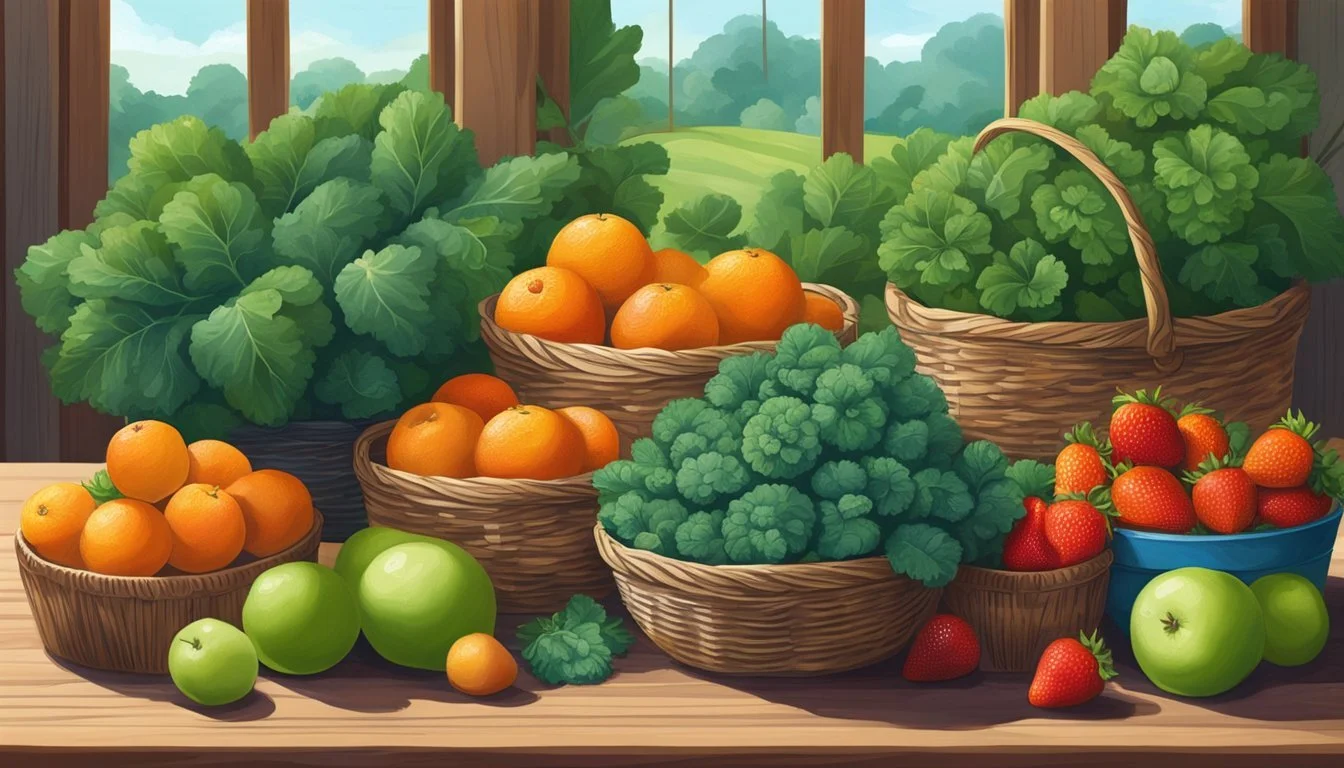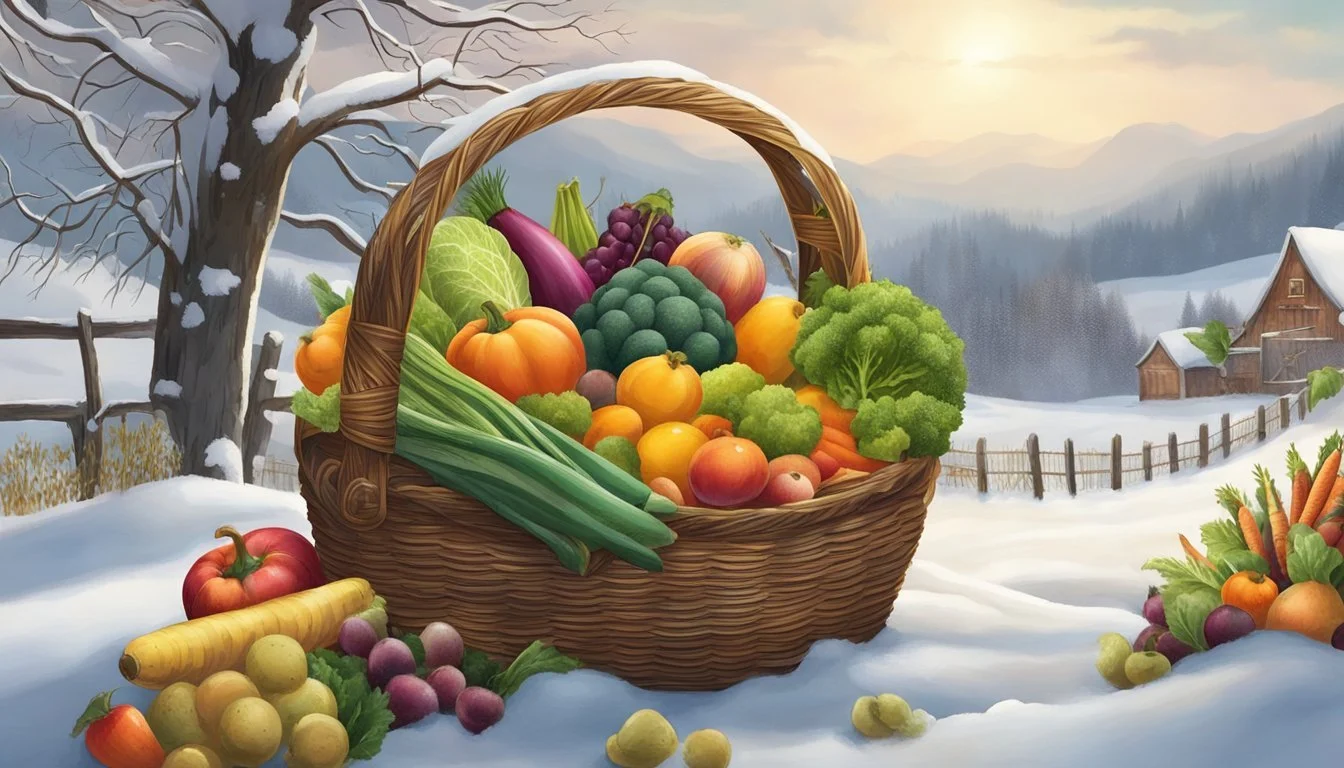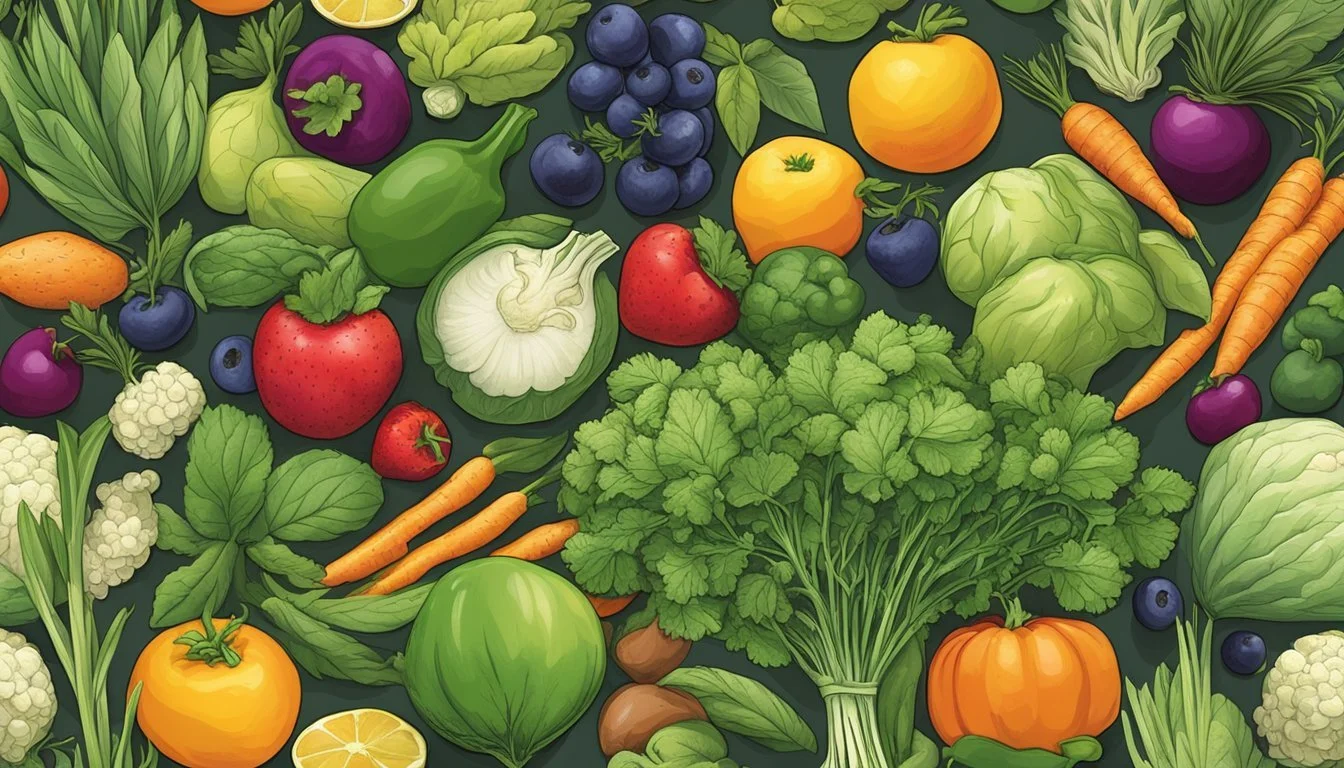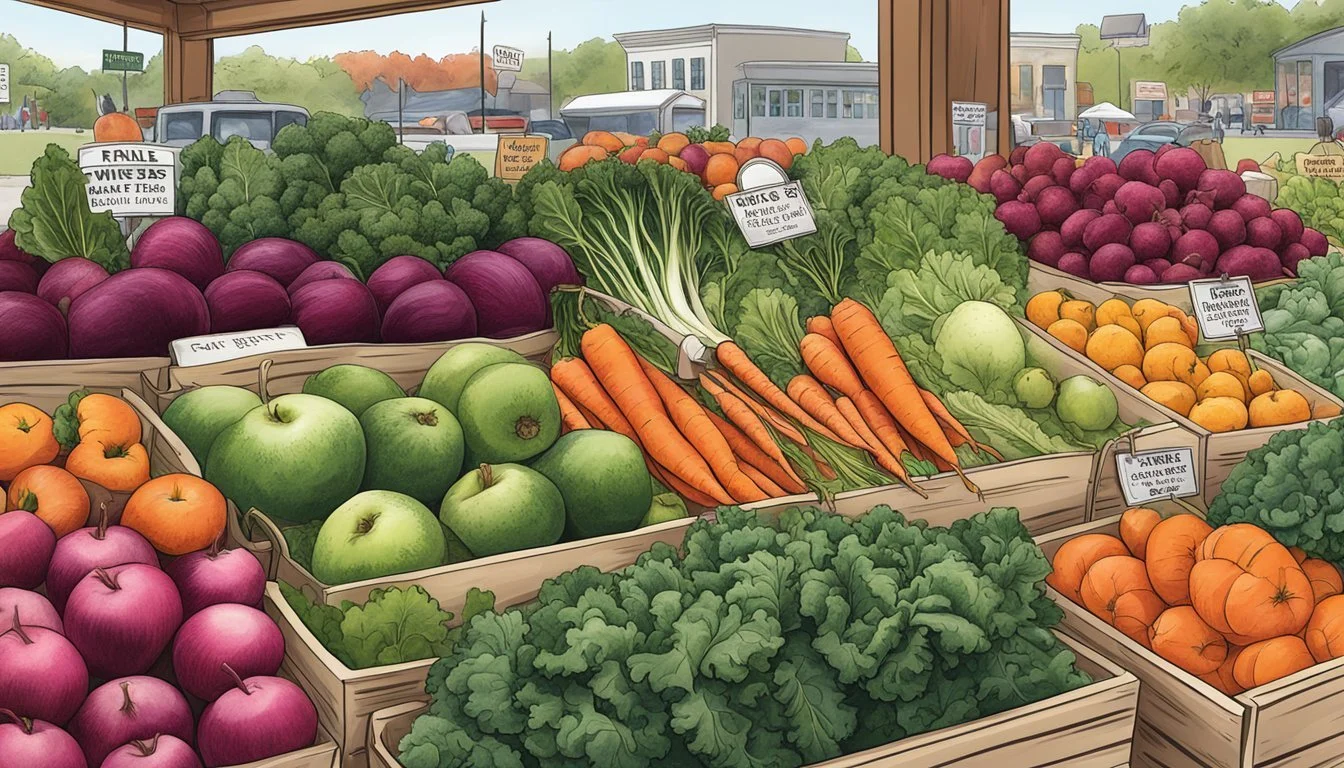North Carolina Seasonal Fruit & Vegetables Guide in February
What's Fresh?
This Article is Part of our North Carolina Seasonal Fruit & Veg Calendar
North Carolina's varied climate and fertile soils create an environment where a diverse array of produce can flourish throughout the year. In February, the state offers a selection of fruits and vegetables that are at their peak of freshness. Consumers can enjoy vibrant flavors and nutritional benefits by choosing produce that is in season.
While February may not be the most abundant month for fresh produce in North Carolina, it is still possible to find a variety of fruits and vegetables that thrive in cooler temperatures. Root vegetables, such as sweet potatoes (What wine goes well with sweet potatoes?), are available year-round and continue to be a staple, while leafy greens like kale remain in season through the winter months. Citrus fruits, although not native to the region, are at their best during this time and are often available due to North Carolina's import of these seasonal favorites.
Choosing seasonal produce not only supports local farmers and reduces the carbon footprint associated with long-distance transportation but also ensures that individuals are getting fruits and vegetables at their nutritional peak. Including these seasonal items in meals can contribute to a sustainable and healthy lifestyle.
Overview of North Carolina's Seasonal Produce
North Carolina offers a diverse range of fruits and vegetables throughout the year, owing to its varied climate. In February, despite the winter chill, local farms continue to provide fresh produce.
Winter Harvest
During the winter months, especially in February, North Carolina maintains a select variety of vegetables and fruits that thrive in the colder season. Vegetables such as collard greens (how long do collard greens last?), sweet potatoes, and turnips are at their peak, offering freshness and flavor that is optimal during this time. While the fruit selection is limited compared to summer and fall, consumers can still enjoy seasonal fruits like apples, which carry over well into the winter due to their long shelf life post-harvest.
Vegetables in season:
Collard Greens
Sweet Potatoes
Turnips
Fruits in season:
Apples
Sustainable Farm Practices
Sustainable farm practices are integral to North Carolina's agricultural ethos, particularly as it pertains to winter produce. Farmers implement crop rotations and cover cropping to maintain soil health and prevent erosion in the off-season. Greenhouses and high tunnels also enable certain vegetables to continue growing, which extends the harvest period and ensures that even during the coldest months, fresh produce is available to consumers. These practices underline the state's commitment to providing fresh and responsibly grown produce year-round.
Fruits in Season
February in North Carolina heralds a modest selection of fruits, predominantly from the citrus family, offering a burst of brightness in the midst of winter.
Citrus Varieties
In February, citrus fruits are a prominent feature of North Carolina's seasonal produce. Shoppers can find a spectrum of citrus that includes:
Blood Oranges: Distinctive for their deep red flesh, offering a sweet flavor with raspberry-like notes.
Lemons: A versatile citrus with a bright, acidic flavor, perfect for both culinary and household uses.
Oranges: Typically sweet and juicy, oranges are a dietary staple for a boost of vitamin C.
Grapefruits: Known for their slightly bitter and sour taste, these are available in both white and pink varieties.
Tree Fruits
Beyond citrus, the range of tree fruits in season is quite limited during this month. However, consumers may still find:
Apples: Stored from fall harvests, they remain crisp and sweet, with a variety of types available.
Pears: Also from storage, pears are enjoyed for their buttery and slightly sweet flavor.
While the chill of winter persists, these fruits offer a refreshing taste that is both nutritious and invigorating.
Vegetables in Season
In North Carolina, February's cooler temperatures sustain a selection of vegetables that offer rich flavors and nutritional benefits. Home cooks and chefs alike can enjoy a variety of root vegetables, leafy greens, and cruciferous vegetables during this month.
Root Vegetables
Root vegetables thrive in the cool February climate. Harvests typically include:
Carrots: Sweet and crunchy, excellent for both raw and cooked dishes.
Garlic: Aromatic, used as a flavor base for a vast array of recipes.
Onions: Versatile in use, ranging from raw salads to deeply caramelized preparations.
Potatoes: Starchy and filling, ideal for comforting winter meals.
Sweet Potatoes: Rich in vitamins and can be used in both sweet and savory dishes.
Turnips: Slightly peppery, good for mashing or roasting.
Leafy Greens
The leafy greens that grow in North Carolina during February are known for their healthful properties:
Kale: Robust and nutrient-dense, perfect for salads and chips.
Spinach: Tender and mild, suitable for salads, sautés, and as a cooked side.
Cruciferous Vegetables
Cruciferous vegetables harvested in February typically include:
Broccoli: Offers a hearty texture and is packed with vitamins; great steamed or roasted.
Cabbage: A versatile vegetable, used in everything from slaws to stews.
Herbs and Other Produce
During February, North Carolina sees a variety of herbs and produce flourishing despite the cooler weather. Herbs such as parsley and thyme are readily available and can be utilized to add fresh flavors to winter dishes. These herbs are not only versatile in the kitchen but also contain nutrients important for health.
Herbs Available in February Thyme Parsley
In regard to green vegetables, arugula (how long does arugula last?) and chard are two nutrient-dense options that thrive in February. Arugula, with its peppery taste, makes a great base for a winter salad, while chard, known for its earthy flavor, is ideal for both raw and cooked applications.
Availability of Greens:
Arugula: Bold and peppery, adds a kick to salads and sandwiches.
Chard: Versatile leafy green, suitable for sautéing or adding to soups.
Basil, commonly associated with warmer months, is less likely to be in season during February, but may still be found in controlled environments like greenhouses. For those looking to include a diverse range of produce in their diets, these herbs and greens offer culinary versatility and a host of health benefits even during the cooler part of the year in North Carolina.
Shopping at Farmers Markets
Visiting farmers markets in North Carolina during February offers a unique glimpse into the state's winter bounty. Shoppers gain access to fresh, seasonal produce and can benefit from the array of items available from local growers.
Finding Local Markets
Farmers markets in North Carolina are abundant, and during February, residents and visitors can still find markets operational throughout the state. The North Carolina Department of Agriculture & Consumer Services provides resources for locating these markets. One can visit the NC Farm Fresh website or Visit NC Farms app to identify the closest farmers market. The seasonal schedule may vary, so it's advisable to check the market's hours of operation before visiting.
Benefits of Local Shopping
The benefits of shopping at local North Carolina farmers markets are multifaceted. Seasonal produce at these markets often comes at a lower cost compared to grocery stores due to reduced transportation and storage needs. Financial:
Cost savings: Seasonal produce is often priced lower at farmers markets due to the abundance and reduced overhead costs.
Quality and Nutritional Benefits:
Freshness: Local shopping provides access to produce that, in many cases, has been harvested within 24 hours, retaining more vitamins and nutrients.
Variety: Shoppers find unique varieties of fruits and vegetables not typically available at commercial grocery stores.
Social and Community Impact:
Purchasing directly from farmers supports the local economy and agricultural community. It also fosters a connection between consumers and the individuals who grow their food, promoting an understanding of the seasonal growing cycles in North Carolina.
Preparing Seasonal Dishes
In February, North Carolina's seasonal produce includes a variety of fruits and vegetables that can be transformed into warming and hearty dishes. This range of items offers a spectrum from sweet and crisp apples to the robust and earthy flavors (What wine goes well with earthy flavors?) of turnips and kale, ideal for winter recipes and versatile cooking techniques.
Winter Recipes
North Carolina's February harvest allows for a breadth of comforting winter recipes. Kale, a winter-hardy green, forms the base of a nutritious and robust kale salad. One could massage the leaves until tender and then toss them with a home-made vinaigrette for a balance of flavors. Apples, available through cold storage, lend themselves to both desserts and side dishes. They can be baked into pies for a sweet end to a meal or roasted alongside pork for a savory-sweet complement.
Root vegetables like turnips present another opportunity for winter recipes. These can be roasted to accentuate their sweetness or pureed to create a smooth and warming soup. Pairing these vegetable-centric dishes with grains or proteins can result in satisfying meals that reflect the seasonal bounty of North Carolina.
Cooking Techniques
The techniques used in February's cooking tend to focus on methods that enhance the natural flavors of the produce while adding warmth to the table. Roasting vegetables brings out their inherent sweetness and adds a crisp texture to dishes. Soups and stews benefit from slow cooking, which melds flavors over time and tenderizes even the toughest of vegetables.
Steaming is another technique that works well with February produce like broccoli and kale, preserving their nutritional value and keeping textures intact. It results in vibrant, healthful side dishes that can be dressed up with herbs and spices or incorporated into grain bowls for a more complete meal.
When preparing these dishes, cooks are reminded that the season's freshest produce requires little adornment. A confident approach to combining flavors, a knowledgeable selection of spices, and the use of clear, simple techniques will result in delightful dishes that honor the ingredients' true characters.
Storage and Preservation
When dealing with winter squash, one should identify a cool, dark, and well-ventilated storage area. The ideal storage temperature is between 50-60°F. They can last for several months when stored properly. It is important not to store them on the ground; elevate them to promote air circulation and prevent rot.
For hard vegetables such as celery root, a similar approach can be taken. They are best kept in the crisper drawer of a refrigerator in perforated plastic bags. The humidity within the crisper drawer maintains crispness and prolongs shelf life.
Pomegranates require a different method. These fruits are best preserved by keeping them in a cool, dry place away from sunlight. They can be refrigerated to extend their shelf life, generally lasting up to two months.
Mushrooms, on the other hand, are best stored in the refrigerator. They should be kept in their original packaging or a porous paper bag to absorb excess moisture. It's crucial to avoid airtight containers, which can cause condensation and speed decay.
Below is a quick reference table for preserving these seasonal offerings:
Item Storage Location Expected Shelf Life Winter Squash Cool, dark area Several months Celery Root Refrigerator crisper Up to a few weeks Pomegranate Cool, dry place Up to two months Mushrooms Refrigerator Approximately one week
One should note that correct preservation maximizes freshness and flavor, ensuring these seasonal products can be enjoyed to their fullest potential.
Understanding Seasonality
When it comes to consuming produce in North Carolina during February, one is engaging with a specific subset of fruits and vegetables that are prime for harvest. Grasping the seasonal availability ensures one can enjoy produce at its peak in terms of flavor and nutritional value.
Seasonal Eating Benefits
Consuming seasonal produce offers a variety of advantages. Freshness is at its peak when fruits and vegetables are consumed in their natural harvesting period. This results in enhanced flavor and nutritional content. Additionally, seasonal eating supports local farming communities economically and can lead to a smaller carbon footprint due to reduced transportation and storage needs.
Nutrient Density: Seasonal fruits and vegetables have reached their optimum growth and are densely packed with vitamins, minerals, and antioxidants.
Flavor: Nature intends for produce to be eaten when it's ripe; thus, in-season items are often richer in flavor.
Seasonal Crop Variations
The diversity of crops harvested in February is less than that of warmer months but still offers a range of options.
Winter Produce: This includes root vegetables and hearty greens that can withstand the colder weather.
Spring Approaching: As February ends, one may begin to see the earliest signs of spring produce.
Typical February Harvest in North Carolina:
Citrus Fruits: Including oranges and grapefruits, replete with vitamin C.
Leafy Greens: Kale and collards, which endure through cooler seasons.
Root Vegetables: Such as sweet potatoes, a year-round staple, and beets.










